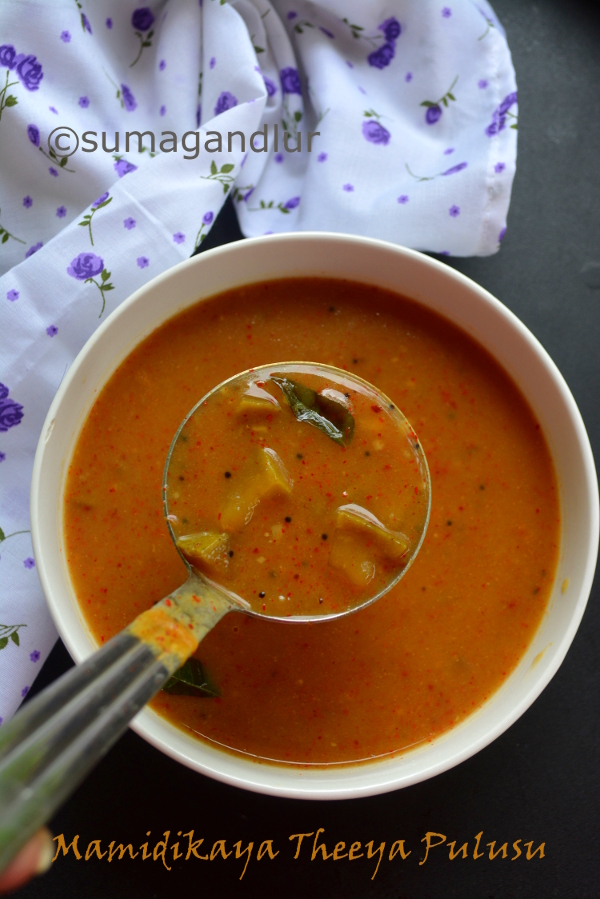Mudda Pappu & Mamidikaaya Theeya Pulusu

There are plenty of combo dishes in Indian cuisine where two dishes gel well and are always served together. Like today's pair of lentils and gravy that comes straight from my kitchen or any Andhra kitchen for that matter.
Muddha pappu is basically cooked lentils with just a seasoning of salt. It literally means lentils cooked to a thick consistency. It is also called otti pappu or chappa pappu which means that the dish is plain / bland. A similar preparation of plain lentils can be found through out the regions in India. However this pappu holds a significant place in Andhra cuisine. Kids in their growing years start their solid food with a little mashed rice, mudda pappu with ghee spooned over. Toddlers and adults have a similar affinity to this dish. My high school going daughter loves this pappu so much that she eats it at least 3 or 4 times per week. Even our extended family members know her love for this and save some plain dal for her during our visits.

Muddha pappu served with hot steamed rice and ghee with aavakaaya on side is the ultimate combo food for a person form Andhra. The other popular pairings that go with this dal rice are majjiga pulusu (Andhra style kadhi), perugu pachadi (Andhra style spicy raita), charu aka lentil based rasam. This mudda pappu is also served when otti pulusu or theeya pulusu is prepared. Otti pulusu or theeya pulusa is a gravy prepared similar to Andhra style dal called pulusu sans lentils. These dishes are never eaten alone with rice in our homes. Usually rice is mixed with mudda pappu and mixed with a tsp. of ghee and dipped in any of these side dishes and eaten.

I prepared otti pulusu today and mudda pappu to go along with it as part of our meal today. Usually otti pulusu is made thinner and no lentils are used. A tsp. of ric eflour is added to slightly thicken the gravy. The dish is a balance of flavors - hot, sour and sweetness and need a little practice to be able to come up with a gravy where all flavors gel well.
Ingredients for mudda pappu:
1 cup lentils / toor dal / arhar dal
2 cups water
1/8 tsp. ground turmeric
Salt to taste
Method:
* Wash toor dal in two exchanges of water and drain. Pressure cook the dal along with water and turmeric for three whistles.
* When the valve pressure is gone, mash the cooked dal with the back of a ladle slightly.
* Add salt to the cooked dal and mix well to combine.
Ingredients: (Yield 3 servings)
1 cup peeled and cubed green mango pieces
1 tsp. oil
1 tsp. mustard seeds
A sprig of curry leaves
2 pinches of asafoetida
1/8 tsp. turmeric powder
2 tsp. chickpea flour / senaga pindi *
1&1/2 cups water
1/2 tsp. chili powder
Salt to taste
2 tbsp. tamarind juice
1 to 2 tbsp sugar / jaggery (I used 3 gm / 3/4 tsp. Splenda)
( * or a paste made with 2 tsp. rice flour and water can be used.)
Method:
* Soak about a big lemon sized tamarind in water until it softens or nuke the tamarind and water in a microwave for 3 minutes. Squeeze the pulp and extract thick juice.
* Cook the mango pieces with little water in a microwave, without turning them mushy.
* Add chickpea flour / rice flour and a few tbsp. of water to a small cup and make a smooth paste. (Rice flour or chickpea flour is used to thicken the stew here since lentils are not used.)
* Heat 1 tsp. oil in a sauté pan and add mustard seeds. When mustard seeds start to pop, add curry leaves, asafoetida and turmeric. (If mango pieces were not cooked in the microwave before, they can be added along with the water now and cooked until done.)
* Next add the cooked mango pieces along with the water used to cook them, tamarind juice, jaggery, chili powder, salt, chickpea flour (or rice flour paste) and about 1&1/2 cups of water to the pan.
* Mix everything with a ladle and check the consistency. It thickens while cooking and the final pulusu should be of pourable consistency like sambhar. Add extra water if necessary and bring the mixture to a boil. Taste and adjust the seasonings, if needed. There must be a balance between the dominant flavors of the dish but the dish is slightly sweeter.
* Lower the heat and simmer for a couple of minutes more.
* Serve with rice, dal and ghee, as part of a Andhra meal.

This goes to Blogging marathon # 89, under the 'Combo dishes' theme. Check out the page here to read what other marathoners are cooking.
Comments


















